
 |
||||||||
|
|
||||||||
|
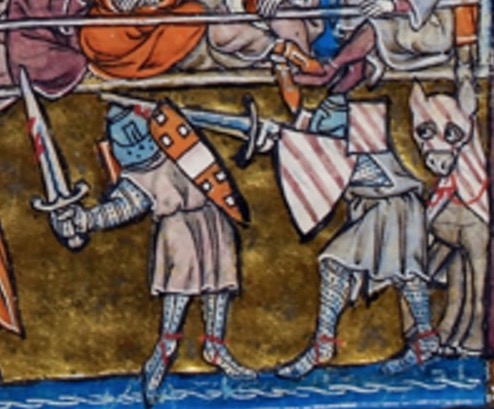 |
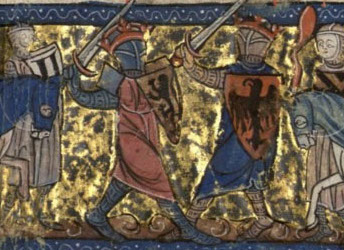 |  |
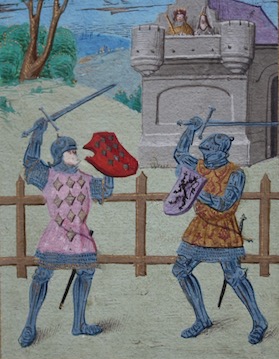 |
For centuries, the fight of double-edged arming-sword with a small
buckler or larger shield was preferred in all manner of chivalric and
judicial duels. Knightly challenges to feats of arms in the chansons and
tales were often described in terms of sword duels on foot. In time
these short swords were largely supplanted for dueling by a variety of
double-handed war-swords. The larger great-sword, the armor-piercing estoc,
assorted single-edged falchions, and later the saber (in both heavy
military and light civilian forms), were all popular choices at one time
or another. The various designs of slender military side-sword were a
common choice throughout the 16th century either on their own or more
often accompanied by dagger or buckler. Versions of these swords found
continual use in duels for the next two centuries. As larger military
swords fell out of use it's easy to understand how more compact
cut-and-thrust designs would become a common choice for dueling.
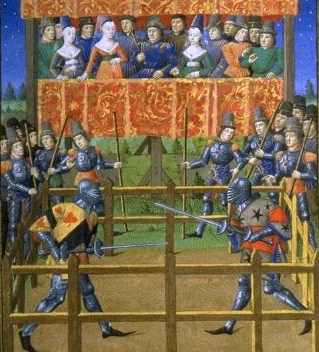 |
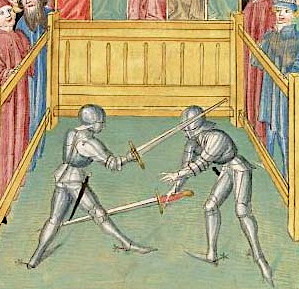 | 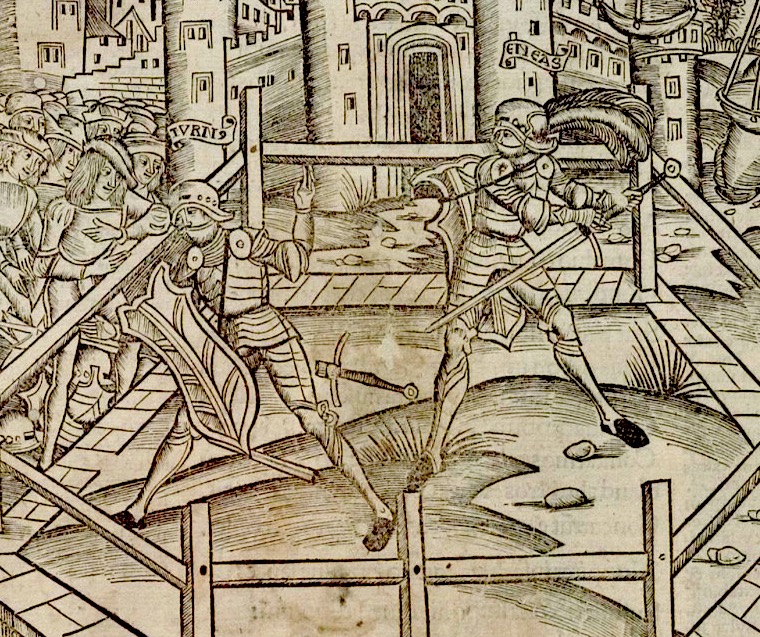 |
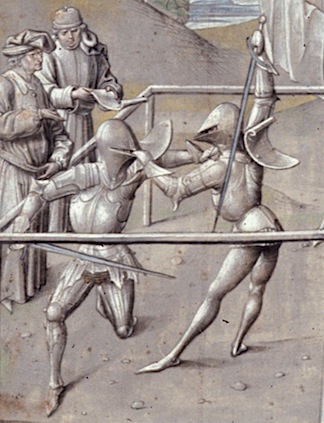 |
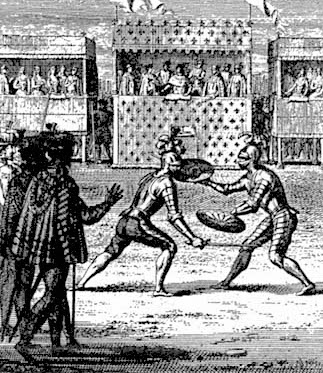 It
was in Renaissance Europe during the 16th and 17th centuries that the
sword duel arguably reached its zenith with all manner of punctillios and cartellos.
The ending of the feudal-era, the rise of larger cities, and the
general banning of judicial combats by the late 1540s provoked a
reaction. The abandonment as a legal means of publicly
settling conflicts directly increased the popularity of its
alternative. Quarrels over issues of honor and reputation would be
settled by the parties themselves through their own means. In that
environment, every gentleman or man-at-arms with such pretensions owned
some form of sword. Typically, a man would fight a duel with his own
personal sword, that being the same one he used in war and carried on
his person, but at other times matching swords were pre-selected so that
neither was longer or lighter than the other. By the 16th century,
special pairs of identical swords, called a case or brace, were kept by
neutral third-parties for this very reason.
It
was in Renaissance Europe during the 16th and 17th centuries that the
sword duel arguably reached its zenith with all manner of punctillios and cartellos.
The ending of the feudal-era, the rise of larger cities, and the
general banning of judicial combats by the late 1540s provoked a
reaction. The abandonment as a legal means of publicly
settling conflicts directly increased the popularity of its
alternative. Quarrels over issues of honor and reputation would be
settled by the parties themselves through their own means. In that
environment, every gentleman or man-at-arms with such pretensions owned
some form of sword. Typically, a man would fight a duel with his own
personal sword, that being the same one he used in war and carried on
his person, but at other times matching swords were pre-selected so that
neither was longer or lighter than the other. By the 16th century,
special pairs of identical swords, called a case or brace, were kept by
neutral third-parties for this very reason.
One cannot consider the sword in duel without examining its nature
and especially the role of the dueling culture in Western civilization.
Unquestionably, no sword in history is as closely associated with the
duel of honor as is that most unique of Renaissance weapons, the slender
foyning rapier. No other sword is as identifiable with the very idea of
the duelist. Though it came into being for urban street fights among
the working class (in an age when guns were becoming increasingly
formidable), within a few generations it was almost the exclusive focus
of fencing masters increasingly concerned with solving the intricacies
of its method in private duel. The evolution of both its blade and hilt
followed directly from this concern. Frequently employed with a matching
dagger and even a simple cloak, the eventual preference for gentlemen
duelists was to use it on its own.
The finesse of a long narrow blade with a quick piercing reach was well
received by duelists and within a generation adopted as their preferred "go-to"
weapon. The danger of fighting unarmored with a slender thrusting sword, with
its blinding speed, deceptive reach, and particular angling of attack
meant that men –especially those still unfamiliar with such fencing–
were very easily wounded. It wasn't that the rapier was intrinsically
more lethal than the fearsome cleaving blows of wider cutting
blades, but that because puncturing stabs simply could not be treated in
the manner of slashes and cuts the death rate due to rapier duels
exploded. There are even notable examples of men seeking out a noted
fencing master for an upcoming judicial combat or before issuing a
challenge in hope of learning some secret technique or special move that
might give them advantage.
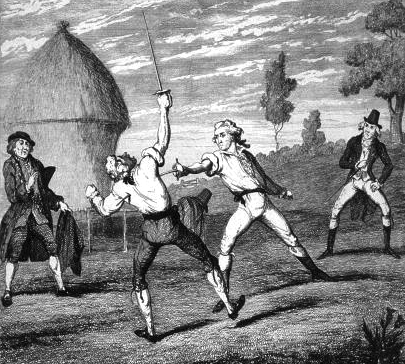 |
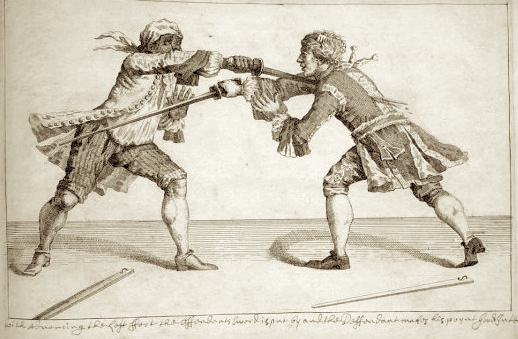 |
The Baroque-era continued the dueling trend as French aristocratic
circles raised the formality and etiquette surrounding the sword duel to
a level never seen before even as firearms were now entirely dominating
warfare. Here the narrow small-sword, as court-sword or walking-sword,
earned preeminence among duelists over military cutlass and cavalry
saber. No other sword form developed so specifically for unarmored
civilian self-defense. Its very function served foremost for dueling
against another small-sword. Though seemingly "dainty", this shorter
thinner blade came on the scene as a less obtrusive personal weapon with
no necessity of encountering the diverse arms and armor of its older
Renaissance cousin. There are plenty of accounts of small-sword duels
being vicious and brutal exchanges devoid of propriety. But comportment
and deportment in a duelist was a product of the Age. While the average
Baroque swordsman might have no compunction whatsoever about coldly
piercing his adversaries chest with his point, striking a fellow
gentleman's face, grabbing his garments, or resorting to unarmed blows
and "vulgar" grappling would be viewed as unseemly and uncouth.
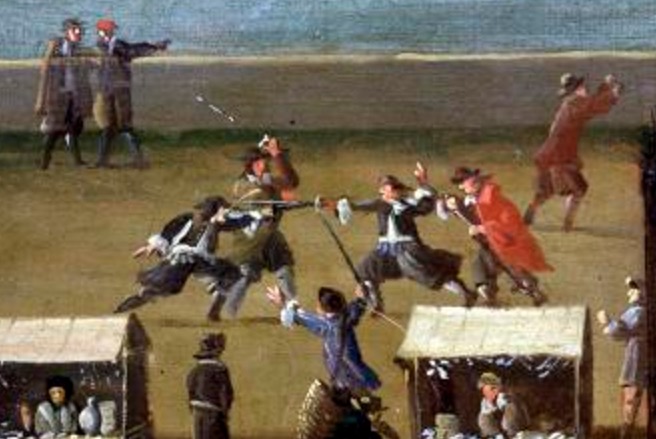 In
the long history of fencing, the idea of two swordsman willing to
non-lethally cross weapons in order to test one another's metal as a
practice fight with training weapons, even at the risk of serious
injury, is hardly uncommon. Indeed, it was likely a fairly regular
occurrence. But this does not rise to the category of duel. Even when
two rival swordsmen had a personal enmity for one another, it is the
intent to seek something more than just "winning" a mock fight on a
given occasion that is the defining characteristic of the true duel. For
encounters to be considered duels there must be something personal at
stake between them. The parties involved must be risking something
beyond a mere test of mutual prowess. There must be the goal of seeking
reparation for tarnished reputation or personal slight by the act of
real violence and the possibility of real injury or death. There must be
a wrong that can only be righted by force of arms, not a sudden brawl
in anger.
In
the long history of fencing, the idea of two swordsman willing to
non-lethally cross weapons in order to test one another's metal as a
practice fight with training weapons, even at the risk of serious
injury, is hardly uncommon. Indeed, it was likely a fairly regular
occurrence. But this does not rise to the category of duel. Even when
two rival swordsmen had a personal enmity for one another, it is the
intent to seek something more than just "winning" a mock fight on a
given occasion that is the defining characteristic of the true duel. For
encounters to be considered duels there must be something personal at
stake between them. The parties involved must be risking something
beyond a mere test of mutual prowess. There must be the goal of seeking
reparation for tarnished reputation or personal slight by the act of
real violence and the possibility of real injury or death. There must be
a wrong that can only be righted by force of arms, not a sudden brawl
in anger.
This definition of dueling blurs because throughout history young men of
hot temper have often "rumbled" for the mere pleasure of earning renown
from their peers or just reveling in displays of armed aggression
against seemingly worthy foes. In cultures where sword duels existed
there were almost always two forms: an unregulated informal kind,
typically occurring on short notice, and an approved version with
certain rules and customs. The latter usually restricted lethality by
proscribing the arms allowed, preselecting the time, and delineating the
permitted space. But for every record of a regulated duel there is
almost always an exception.
 |
While there are sporadic instances throughout history of single
combat challenges on the battlefield or in feats of arms as a means of
seeking valor, it was only within Western Europe that a true dueling
culture of swordsmanship found full expression. Both the ancient Greeks
and the Norse recognized occasions for individual challenges to settle
disagreements or accusations sword-to-sword and there are a few recorded
instances of samurai duels, such as those by the famous, Miyamoto
Musashi, in the 17th century. Yet, these took place as exceptions rather
than the rule. Roman gladiators, though usually engaged in single
combats, were not dueling because they very often fought against their
will or against others who did not freely enter the combat. More
importantly, they did not have personal grievance as their cause but
were fighting as spectacle or entertainment (not to mention that such
fights were not necessarily to the death or even to cause serious
injury). Singling out an opponent on the battlefield or being ordered
into the arena is not quite the same as willingly stepping out or
arranging ahead of time to specifically fight one on one without
interference.
There are also notable accounts of rival fight-school challenges at
European festivals and fairs from the late 15th all the way into the
early 18th centuries. Although these used all manner of swords that
could cause serious harm and allowed for cutting blows that frequently
bled their unarmored combatants, they nonetheless had their bouts
arranged as promotional displays and training events. Sometimes there
were personal rivalries and sometimes unintentional deaths occurred. The
public "prize fights", such as held by the London masters of defence,
were public exhibitions to test their students in a series of matches
against their fellows using blunt weapons. These were later revived
commercially as much bloodier "gladiatorial" combat sports in the late
17th century. But this was not about dueling and these were not true
duels.
There have been duels with knives, with spears, even axes and plenty
with pistol. Many also took place on horseback. But it was always the
sword on foot that remained the premier individual arm of self-defense
suited to all occasions. The selection of the sword as the weapon of
choice for a duel had deliberate meaning. The sword was an armament
whose only function was combat —not hunting or farm labor in the manner
of an axe, pole-arm, or bow. Using a sword implied knowledge of
swordsmanship, which meant being educated in arms as a member of the
military class or nobility (or having pretensions to such). In a social
and cultural context the sword was both representative as well as
symbolic of status, faith, and honor. With the sword you had to get up
close. You had to make physical contact with your adversary. You cannot
engage them without exertion and deliberate intent as well as incurring
danger. The sword gave the duelist satisfaction by his drawing blood in
the face of possible death. When it comes to a sword duel, it's
personal.
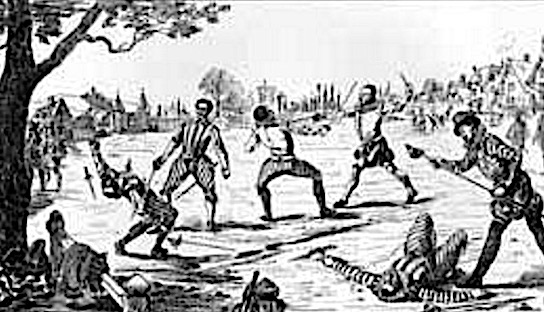 |
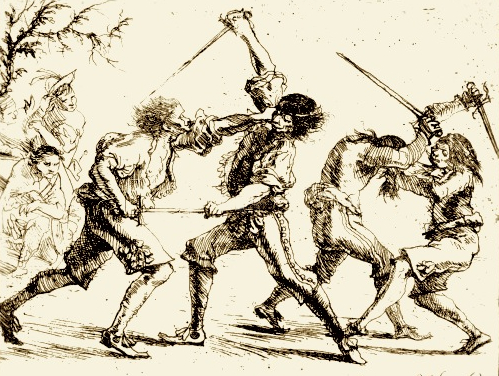 |
A sword duel is seldom viewed as an act of civility but that's
precisely what it was. All legal and theological arguments against it
aside, the duel served a means of settling conflicts while avoiding
direct homicide. There are no rules when fighting for your life, and
yet, that is exactly what a duel demanded: that in a fight you agree to a
certain set of prohibitions for how to start and how to finish. The
sword duel survived for so long because it provided an outlet. It
channeled natural violent impulses and directed unavoidable hostility by
permitting an acceptable manner of fighting that assured some degree of
fairness and honesty between the combatants. Just as importantly, it
allowed recognition of it among ones social peers. Honor among duelists
was about more than mere reputation or face saving; it was about
behavior, expectation, etiquette, masculine personae, and adherence to a
set of martial norms. The dueling culture was sword culture and there
were many who took delight in it.
It's easy to romanticize sword duels as the manly means to prove
one's worth and reputation while ending private feud and avoiding
vendetta. But just as easily it could be abused, exploited, and produce
nothing but wasteful senseless death. From the record it would seem that
private duels of honor were rarely honorable and seldom private. Nonetheless, it's also easy to
recognize its appeal. If two men agreed to settle a matter between them
by consensual force of arms there was no better way than the honest
clash of steel. To accept such a challenge, to face it down and claim
victory through your own skill, whether the opponent was spared or
slain, was the surest way to defend a smear, insure the value of your
word, or earn renown outside of war. In that regard, the ability to
wield the sword matched with the willingness to use it over such matters
was seen as a sign of character. The paradox of the private duel was
that to earn repute or acquire notoriety, it could not be entirely
private, or else the victor might be construed as having intentionally
arrange a murder by ambuscade. Thus, at least some public witnesses or
neutral spectators were typically required. Avoiding the attention of
the authorities was the catch. In general, dueling was an extralegal
activity of the aristocracy and the state, though issuing numerous bans,
generally turned a blind eye if it were done discretely.
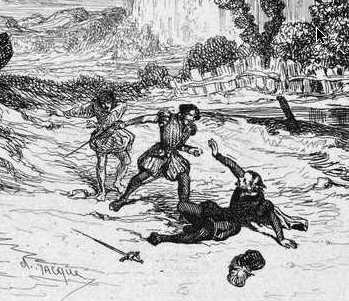 |
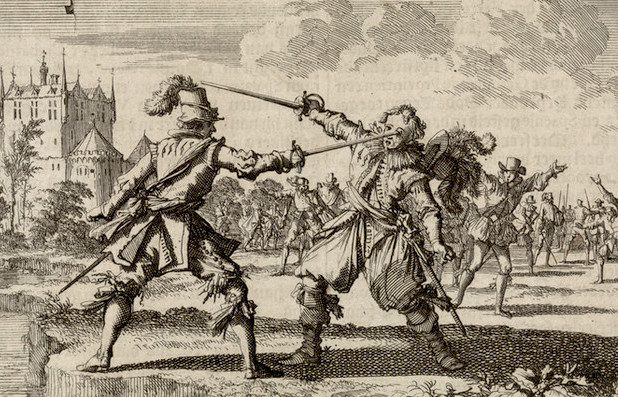 |
Yet, sword duels could be impromptu affairs with nothing formally
declared and only the understanding that once blades were drawn no one
was going to interfere. There might not even be any explicit expression
of what outcome was expected until it was all over with either one or
possibly both parties wounded or slain. In many cases, the label of
"duel" seems to have been applied to such spontaneous fights after the
fact. To be sure, the formal duel was far less common than were simple
back alleys assaults and gang fights in empty piazzas and wooded paths.
To face off mono-a-mono, having selected one of a pair of equal blades,
and backed by your second, awaiting the command of a neutral third-party
before killing or being killed, was an experience reserved for a select
few. Many sword duels were fought only until the slightest blood was
shed and the aggrieved party satisfied –a result easily achievable by
swords in particular. But many more were expressively fought to the
death.
Curiously, as Warfare in the West became more industrial, more
mechanized, and more lethal during the mid-to-late 19th century, Western
fencing became sportified. It transitioned into a safe athletic pastime
and recreational game at the same time the gun-culture entirely took
hold. But the sword duel for matters of personal honor persisted. A
longer and lighter dueling version of the épée' emerged strictly for
conducting such affairs as did a thinner and lighter "civilianized"
sabre. When clerks, lawyers, and journalists could find excuse over any
trivial minutia to "duel" in the park using featherweight weapons
employed in a manner to produce mere pinking wounds, things were reduced
to near farce. As the 20th century approached, sword duels had been
reduced to a highly regulated activity seldom offering any serious
danger to its participants and deaths by sword wound were a rarity.
Meanwhile, the contrived rituals of 19th century German university
"dueling" clubs with their non-lethal blades, diluted their formalized
bouts down to an artificial scar-inducing fetish serving as little more
than "extreme fraternity hazing." It took the horrors of the Great War
of 1914 to not only end the honor culture of Western civilization, but
extinguish entirely the idea that manhood and reputation was best made
worthy by encountering edge or point in ritualized single combat.
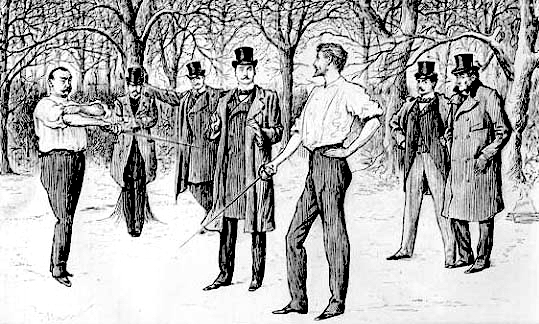 |
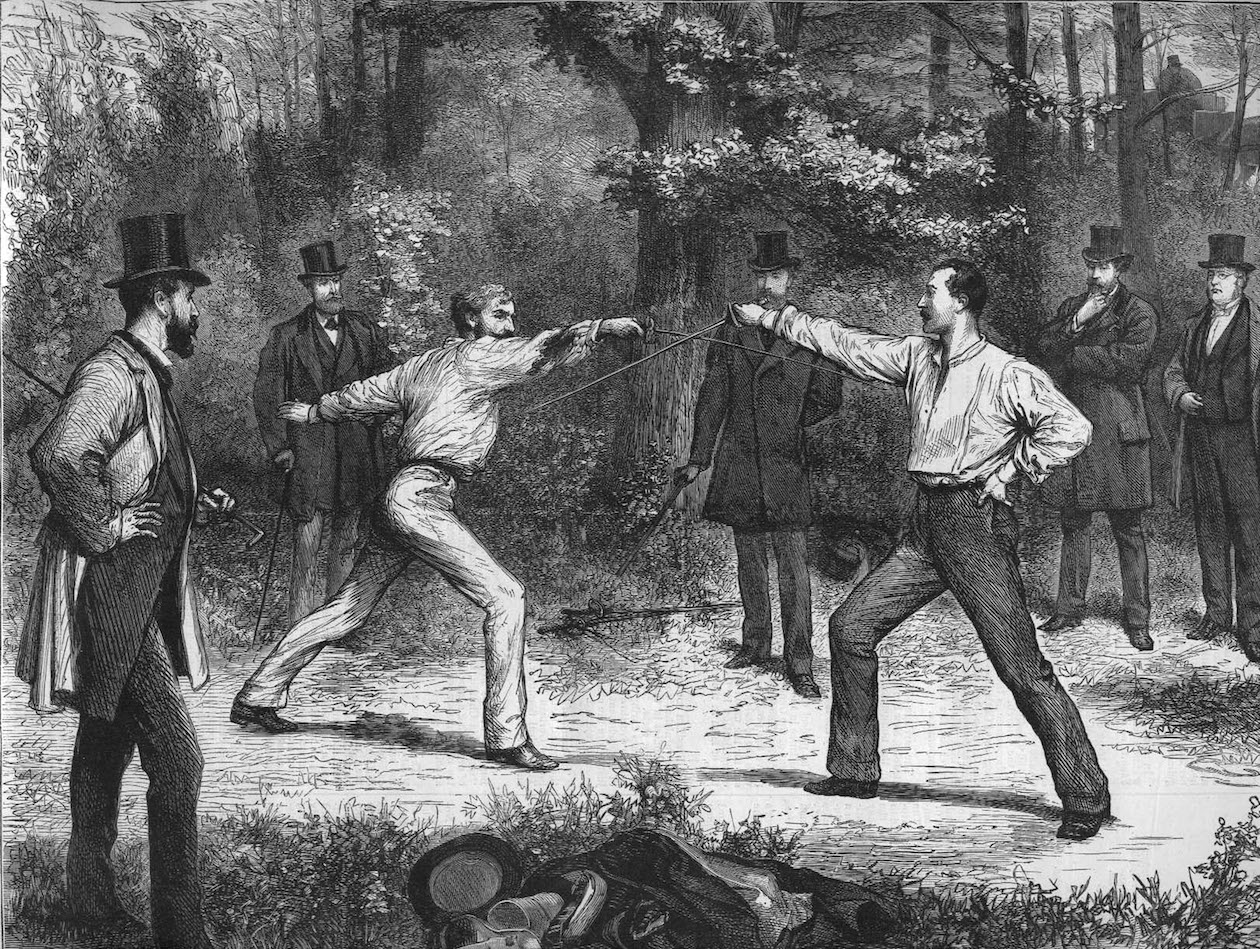 |
The history of the duel is long and complex but the general idea that
two people may choose to settle a private dispute or resolve a conflict
by mutual consent is an ancient one. There are probably as many
examples of sudden on-the-spot duels taking place as there are those
that required extensive negotiations to arrange. And there are examples
of duels being fought between two parties that had no quarrel or cause
whatsoever between them other than they wished to fight someone or
otherwise thought it expected of them by their peers. For every
reluctant duelist there was the sociopathic bully who purposely sought
out or gave offense in order to provoke a fight he was sure to win. For
every sword duel that ended amicably with the two parties shaking hands
before heading off to share a drink there were perhaps a dozen that
ended in complete animosity with one or both parties mortally wounded.
Nevertheless, there has long been a recognition that among duelists (as
well as competitors in combat sports) that they share an intimacy which
very often ends in mutual respect. There was an honesty found in
allowing two capable individuals to just "fight it out" if they wanted.
The problem was, they usually wanted too often for too stupid a reason.
Again, it's important to understand that social forces have always
had a profound influence on how men choose to defend themselves or
engage in ritual combats. We have to avoid looking at it from our
perspective rather than from the context of the original time and place.
A man who was willing to risk his life and the taking of life at the
point of a sword, yet abide by rules of what was considered decent or
indecent when fighting would be looked upon with admiration and respect
by his peers and opponents alike. If two similar men survived a serious
duel it was often easy for them to forgive and forget not to mention
enjoy the notoriety they had mutually earned regardless of victory so
long as they had both acted with proper decorum.
|
|
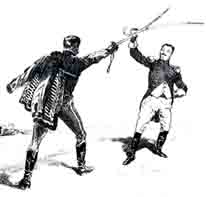 |
It's difficult from our perspective today with our instant
communication and global media to grasp that the primacy of individual
dignity was once solely a matter of the local communities within which a
gentleman personally operated. This compelled and demanded he answer
slander and accusation by a willingness to back up his reputation
through skill in arms. A price had to be paid by those who besmirched
him. By providing protocols and structure to interpersonal violence that
would have happened anyway, dueling directed the impulse into the
something less socially damaging than outright open combat. In offering
opportunity for redress a duel was a means of preserving social order
and limiting revenge in a violence prone society accustomed to constant
death. The problem was that it came to generally force those who did not
want to participate in settling "idle quarrels" to do so anyway,
thereby causing a massive and unnecessary loss of life.
With few exceptions, the majority of sword duels we know of are those
occurring among the nobility, recorded by the nobility for a readership
of nobility. They naturally favored accounts that upheld the
aristocracy's ideas about "honorable quarrels." Single combats among the
common folk and duels that did not abide by preferred rules of decorum
and etiquette held little interest to such historians, even as it's the
more unusual duels that tend to stand out to us today. On top of this,
cinematic depictions of sword duels and fictional descriptions in
popular culture invariably overextend sword fights into exaggerated
exchanges of dramatic parry-riposte action. Duels are frequently shown
where disarming the opponent or merely threatening to finish them off is
sufficient to end the affair as the victor proves his superiority as a
swordsman. The reality from the genuine accounts and fencing sources is
that the real things were much shorter and far more violent.
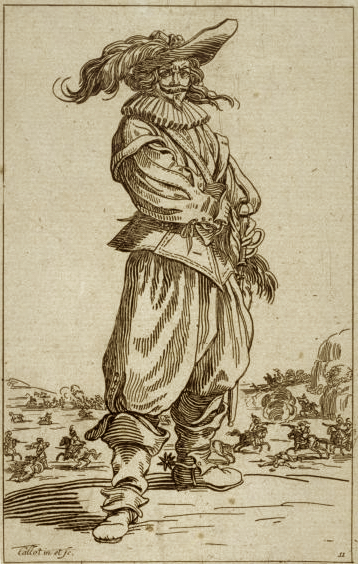
Considerable European literature was certainly produced from the 16th
century onward on either supporting or condemning duels. Arguments were
offered for the virtue of reason over rage as well as what was "just"
or sufficient cause to settle a personal matter by "calling out" the
other party. The truth lies somewhere in between. As the Elizabethan
master of defence, George Silver, counseled in 1599, "Take not arms upon
every light occasion" and "Do not upon every trifle make an action of
revenge or of defence."
Silver gave perhaps the most authoritative disapproval of dueling over the provocation of mere words:
"...he that will not endure an
injury, but will seek revenge, then he ought to do it by civil order and
proof, by good and wholesome laws,
which are ordained for such
causes, which is a thing far more fit and requisite in a place of so
civil a government as we live in, then is the
other, and who so follow these
my admonitions shall be accounted as valiant a man as he that
fights and far wiser. For I see no reason why
a man should adventure his life and estate upon every
trifle, but should rather put up divers abuses offered unto him,
because it is agreeable to the
laws of God and our country."
Yet, while advocating legal recourse for slander, Silver wholeheartedly
endorsed the necessity of armed self-defense whenever necessary:
"Why should not words be answered
with words again, but if a man by his enemy be charged with blows then
may he lawfully seek
the best means
to defend himself and in such a case I hold it fit to use his skill and
to show his force by his deeds..."
Commenting on the topic of provocation by "fighting words" in his
fighting treatise of 1617, the English fencing master, Joseph Swetnam,
observed that: "As there are many men, so they are of many minds, for
some will be satisfied with words, and some must needs be answered with
weapons." Swetnam understood that sometimes some people just needed to
be made to answer. Yet, he further warned the potential duelist to,
"meditate thus with thy self before thou pass thy word to meet any man
in the field." Swetnam still advised, that when you come into the
dangers of the dueling field, "being loath to kill...Then thy enemy, by
sparing him, may kill the, and so thou perish."
The tradition of sword duel survived the advent of firearms even as
ballistic weapons forever ended the primacy of edged weapons in war and
personal defense. The personal quest for prowess and recognition of
skill in a "fairly" contested invitation to bloodshed combine in the
romance of the sword duel. Our modern fascination with it revolves
around longstanding ideas of manliness, the problem of youthful
aggression, and the honing of a warrior spirit. Even the very word
"duel" has come now to mean any type of high stakes struggle between two
opposing parties.
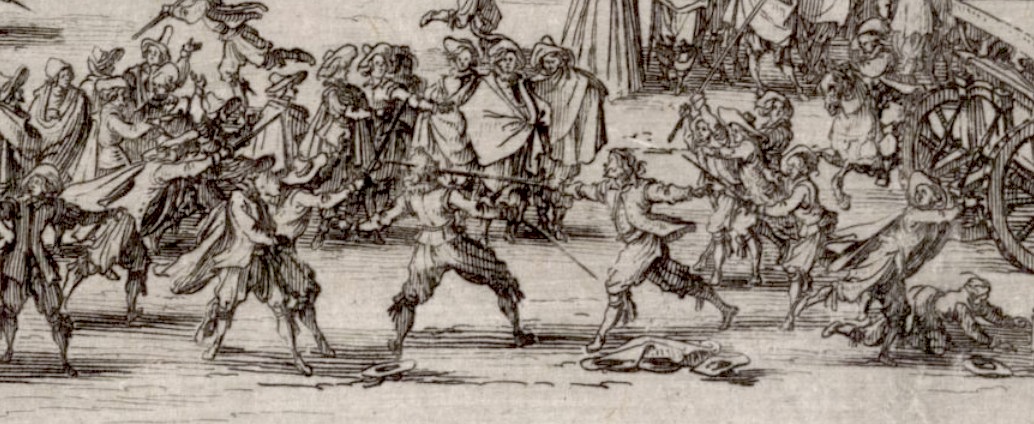 While
dueling might seem like it would just lead to the biggest toughest guy
being free to express invective and make disparagements because he won't
be challenged, that wasn't really the case. The fact is, the duel
actually offered a certain sort of fairness in that weapons are the
great equalizers. Though physical strength and size is a bonus in
fighting, skill supersedes it. It doesn't matter how big and strong you
are when an ordinary sword point can just as easily pierce through your
face or belly and a sharp edge just as easily remove your hand or sever
your kneecap. This is likely why so few historical duels were settled by
fighting unarmed (and why duels with pistols came into being).
Because fencing skill by its nature is about discipline and self-control
it meant you had accomplished some training and were expectedly less
likely to say something rash and impolite. Though there are plenty of
infamous exceptions, generally, people with an appreciation for weapons
and a confidence in using them don't usually go about provoking the
kinds of offensive verbal exchanges that lead to real fights. (One need
only look at online comment threads or Twitter exchanges
—where physical confrontation is an impossibility— discourse is
quick to break down. It's not about being unable to ignore insults but
rather about making dishonorable characters pay a price for disreputable
acts against you.
While
dueling might seem like it would just lead to the biggest toughest guy
being free to express invective and make disparagements because he won't
be challenged, that wasn't really the case. The fact is, the duel
actually offered a certain sort of fairness in that weapons are the
great equalizers. Though physical strength and size is a bonus in
fighting, skill supersedes it. It doesn't matter how big and strong you
are when an ordinary sword point can just as easily pierce through your
face or belly and a sharp edge just as easily remove your hand or sever
your kneecap. This is likely why so few historical duels were settled by
fighting unarmed (and why duels with pistols came into being).
Because fencing skill by its nature is about discipline and self-control
it meant you had accomplished some training and were expectedly less
likely to say something rash and impolite. Though there are plenty of
infamous exceptions, generally, people with an appreciation for weapons
and a confidence in using them don't usually go about provoking the
kinds of offensive verbal exchanges that lead to real fights. (One need
only look at online comment threads or Twitter exchanges
—where physical confrontation is an impossibility— discourse is
quick to break down. It's not about being unable to ignore insults but
rather about making dishonorable characters pay a price for disreputable
acts against you.
Admittedly, there is an undeniable satisfaction in calling out someone
who wronged you and watching them back down out of cowardice or
dishonesty because they're unable or unwilling to match their tough talk
with blows. The fear of physical punishment did indeed deter harsh
words and bad behavior. But, if an opponent was willing to fight and you
were to lose, well, there is still satisfaction in having proved your
willingness to endure the danger of injury or even death over insult or
dishonor. None can deny the respect earned by standing up for yourself
or that, paradoxically, the original offense is mitigated by it. Again,
this is difficult to relate to in our modern age because fighting one to
one over an affront seems like a resort to something primitive and
irrational.
To better understand the role of the sword in duel consider that it
was a personal side-arm closely worn because it was relied on for safety
and survival. It offered an innate capacity to adeptly threaten with
point or edge, to deftly ward off blows, to slash and bash, and to
increase the effectiveness of all this through personal discipline and
study. How could such a valuable object not be highly prized and
lovingly decorated? Curiously, in societies where arms are openly worn
incidents of both sudden violence as well as violent crime are less
frequent. The fact that disrespect and insult can be met with injury or
death does indeed encourage people to better behave themselves around
one another. There was a simple truth at work in an armed society: if
you don't want to risk provoking a duel then avoid angering those who
won't tolerate the indignity of incivility or innuendo. Nothing else
discouraged rudeness more thoroughly –or forced an apology more quickly–
than the possibility of it being answered with a challenge to private
violence. As the erudite swordsman adventurer, Captain Sir Richard
Burton, famously declared in the mid-19th century,"As soon as the sword
ceased to be worn in France, the most polite man became the rudest."
There is an undeniable truth to his observation that in our digital age
of online discourtesy holds growing appeal to the modern student of the
sword.
For historical fencing practitioners today, the interest in how swordsmen once prepared for sword duels they would perhaps never have is really not all that different than our own exploration. One cannot examine either antique swords or authentic teachings for their use without regard to how they applied to the dueling tradition. In that regard, we continue their legacy through our own training. It is this long connection between the duel and the sword, between personal single combat and personal sidearm, that is such a part of why it was the unrivaled weapon of choice for defending honor and seeking private justice. The sword in duel may perhaps even have a history stronger than the sword in war.
See also: The Sword in War
3-2017
|
|
|||
|
|
|||
|
|||